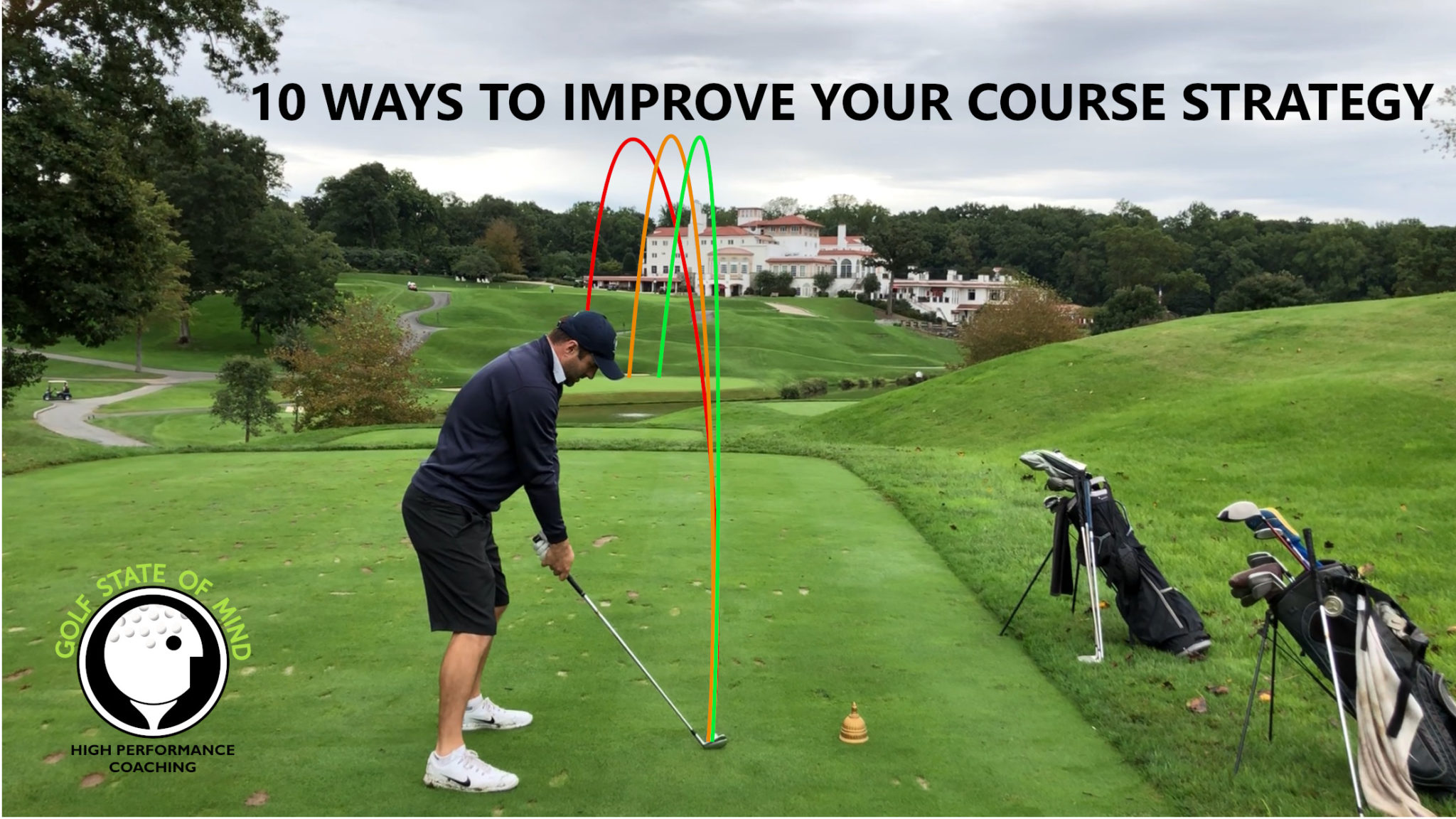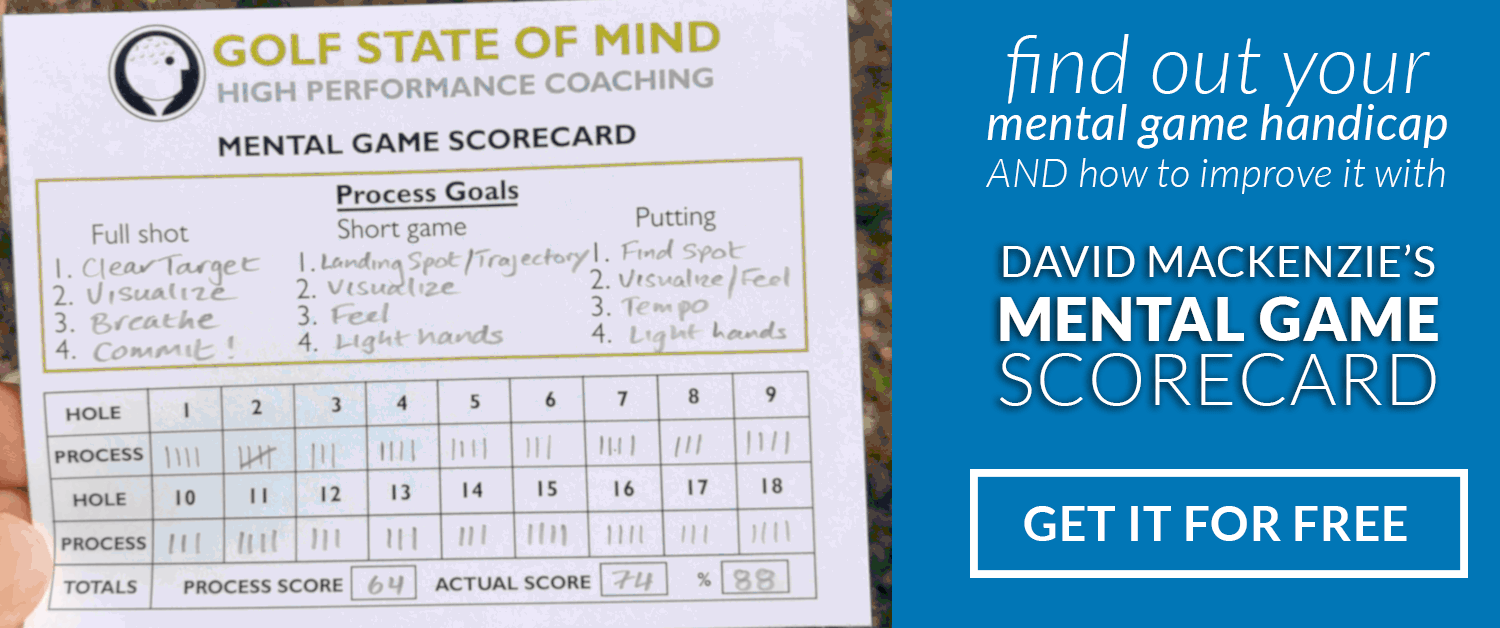
10 Ways To Improve Your Course Strategy And Lower Your Scoring Average
Whenever I give a playing lesson with a new student and I ask them about their targets and shot selection, it often becomes clear that they are losing several shots each round due to poor course strategy for golf. The good news about this, is that it becomes a very easy way to shave shots off their score almost immediately.
I’ve played with Tour players before, who on the face of it don’t look all that impressive until you see a 66 on their scorecard at the end. They’ve successfully plotted their way around the course to maximize scoring opportunities while limiting mistakes. Tour players miss their targets more than you think, but their misses are usually “good” and their shot selection and targets they pick gives them the best chance of getting up and down and ruling out the big numbers.
An improved course strategy for golf is about getting more from what you already have, which is essentially what a better mental game of golf is all about.
In this article we’ll take a look at 10 ways you can improve your course strategy for golf, and lower your scoring average.
10 Ways To Improve Your Course Strategy For Golf
1. Know Your Distances
This one sounds obvious, but it’s surprising how few golfers (even single figure golfers and better) know how far on average they hit the ball. Here’s a typical conversation about course strategy for golf with a new student:
Me: “How far do you hit a 7-iron?”
New student: “175”.
Me: “Is that when it’s well-struck or on average?”
New student: [Pause] “Actually, when it’s well struck”.
Me: “So how far do the other 50% of your 7-irons go?”
With launch monitors becoming more accessible (your local pro will typically have a Trackman or Flightscope) and inexpensive (you can get something fairly accurate for less than $500 now), there’s no excuse for not knowing how far on average you hit each club. It’s well worth the investment of time to hit 25 balls with each club (with balls that you use on the course) and see what your average carry and roll is.
2. Know your Shot Dispersion
If you were to hit 25 balls with a 5-iron, do you know what the grouping of the balls would look like? Knowing how narrow or wide your shot dispersion is (left and right, long and short), will really help you make better misses. Using a Trackman or Flightscope can tell you this.
E.g. If you are faced with a shot from 190 yards with water to the right and the pin is on the right of the green (like in the photo above) and your shot dispersion (left-right) from that distance is 40 yards (20 yards left or right of the target), then clearly aiming at that pin is going to bring the water into play. However, if you were to aim 20 yards to the left of the pin, you can safely assume that you will not be in the water or short-sided right. You’ve immediately taken a step to eliminate a big number.
Tour players adopt a similar strategy. Despite what you might think from watching the TV coverage, they rarely aim at pins, especially if the pin is close to one side of the green. When you see those shots go close on TV, it’s usually because they’ve hit it to the very edge of their shot dispersion. Their actual target was probably the safe side of the green to avoid being short-sided or bringing a big number into play.
3. Know The Good and Bad Misses
The players I work with make good use of yardage books and Google Earth imagery as part of their prep for a round. Knowing where you can’t go on a hole is not negative thinking, it’s a key part of a good course strategy for golf. Obviously you rarely know where the pins will be located until the tournament day, but during your prep, imagine 3 possible pin locations and formulate a strategy based on those possibilities. Some of my students like a “Red, Amber, Green” approach where Red is a more conservative target and playing away from the pin and Green is a more direct shot at the pin. Put these notes in your yardage book to remind you when you’re on the course.
4. Get The Ball Into The “Scoring zone”
One strategy system that’s helped a number of my students is Will Robin’s “Scoring Method”. This system helps golfers better understand their game and formulate a strategy to limit mistakes and maximize scoring potential. It also helps each player figure out exactly what they need to work on during practice.
One of the key concepts is figuring out what you need to do to guarantee that you can get into the “Scoring Zone” in regulation (the size of the scoring zone varies for different levels of player). To learn more about “The Scoring Method”, click here.
5. Know How Lie Affects Distance
Are you aware of how different lies affect the carry of each club? It’s these details that the world’s best players are factoring into their decision making for every shot. From the fairway or tee box is where you’re going to get maximum compression of the ball with your irons (the ball gets squeezed between the club and the ground). From the sand or rough there is obviously less compression and therefore the ball is not going to travel as far.
6. Know Your Favorite Wedge Yardage
Another mistake I see players make, especially on short par 4’s or when hitting approaches into par 5’s, is trying to hit the ball as far down the hole as possible. When I see a player reach for a 3 wood for an approach into a par 5 and I ask them what yardage they expect for their next shot, the response I often get “I’m just trying to get it as close to the green as possible”. But If you feel less comfortable hitting a shot from 50 yards, than you do 100 yards, then why would you want to have the shorter shot in? Not to mention, a 3 wood has a higher dispersion than say a 5-iron and you’re more likely to be out of position.
Work your way back from the green and think about how to get to your favorite yardage and what angle you’d like to play the next shot from.
7. Know The Holes Where A Bogey Is An Acceptable Score
When you look at the scorecard before a round, take note of the lower stroke index holes. If you know that the average score on a particular hole is likely to be over par, then take a more conservative strategy on those holes. Lowering your expectations will take some pressure off you on those harder holes. You might be better off taking a shorter club off the tee to guarantee you keep the ball in play and in position and still give yourself a chance of making par (and bogey being your worst possible score), and at the same time, ruling out the big number.
8. Know When To Take Your Medicine
Too many golfers take on too much risk when they are out of position. On those days that you have your B or C game (which happens to every player from time to time), it doesn’t mean that you have to score badly. Those rounds where you aren’t as in control of the golf ball are not the time to be taking on risky shots. When you’re out of position, select shots that are going to get you back in play with a chance to score. Avoid shots that you don’t feel comfortable hitting – the additional pressure to execute them and any lack of commitment will more than likely result in a poor swing and more mistakes.
9. Improve Your Golf IQ
Your Bryson DeChambeau’s and Phil Mickelson’s of the world know exactly how a degree of air temperature change will affect the distance the ball will carry and roll. They are also great at being able to judge wind speed and they know exactly how much each mph of wind speed will affect the distance. Bryson Dechambeau was seen recently spraying his balls with water on the range to simulate wet conditions and measuring the distance change using a launch monitor. I’m not suggesting you go to this extent, but at least understanding how different conditions affect distance and carry is an important factor of a good course strategy for golf.
10. Score Your Rounds By Factors Such As Your Course Strategy For Golf
All of my students use what I call a “Mental Game Scorecard”. When you are on the first tee, your technical skills are what they are. What will bring out the best in your game and help you access your best skills on that day is the mental game, and that’s what my students score themselves by. Course strategy is one of these factors and scoring yourself by it at the end of every round will make you more aware of it during your rounds. To get your free copy of my mental game scorecard, click below.


